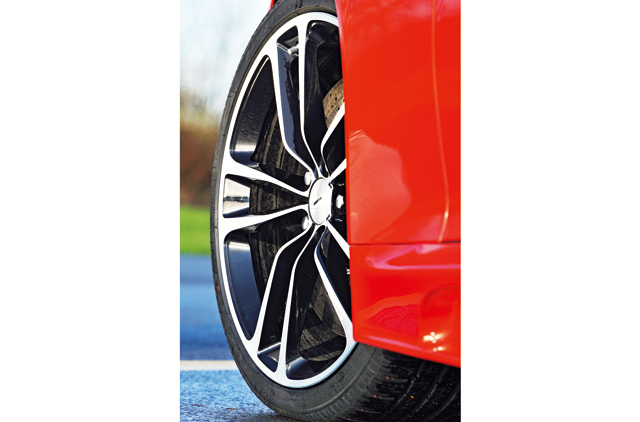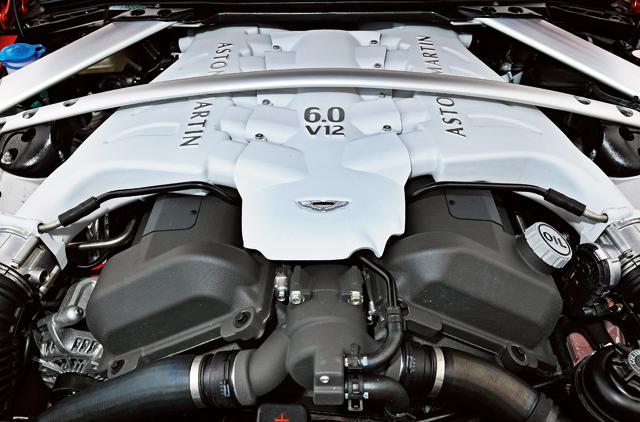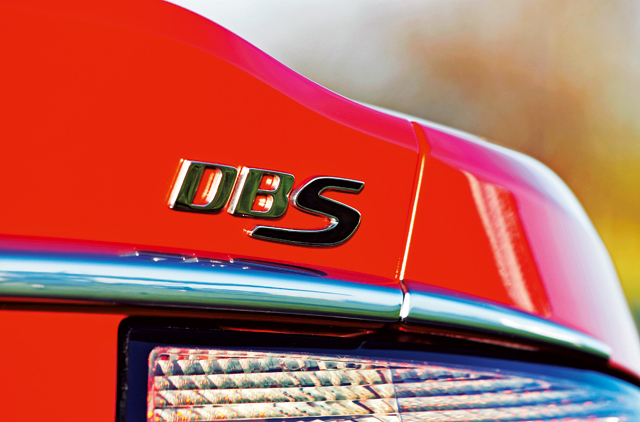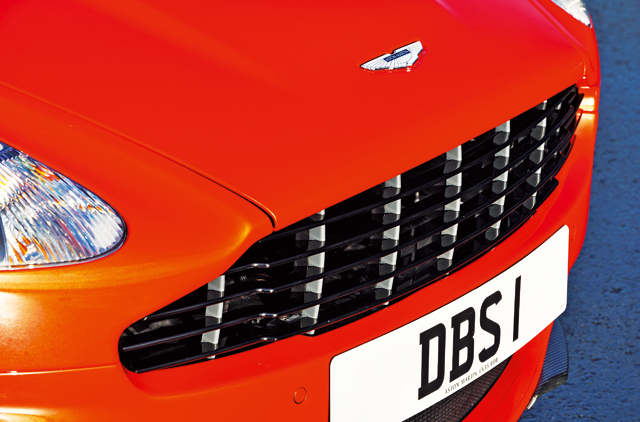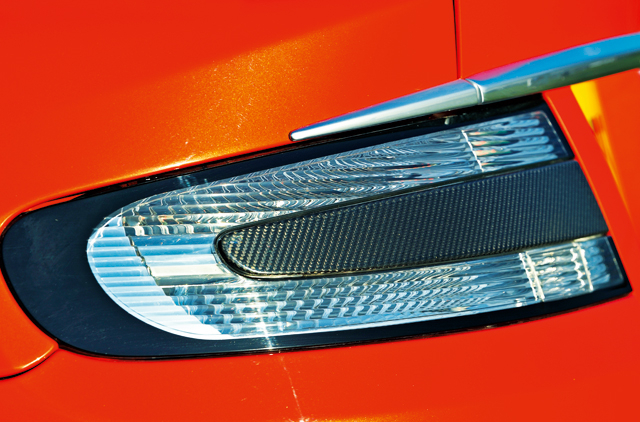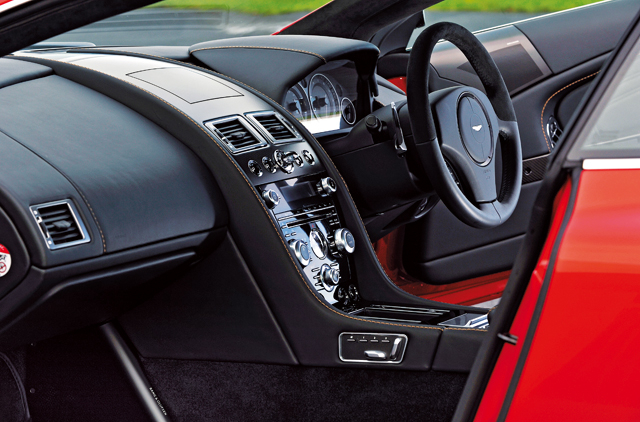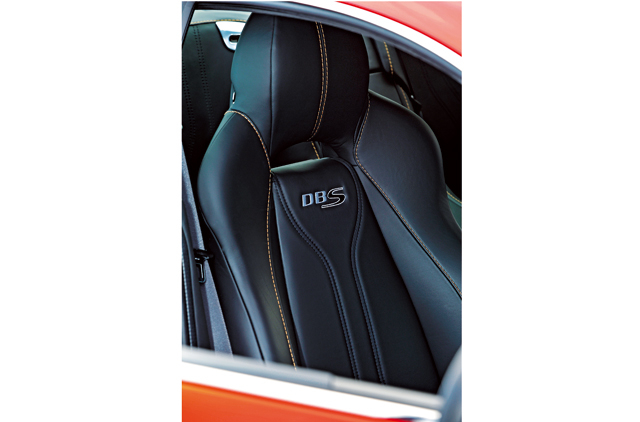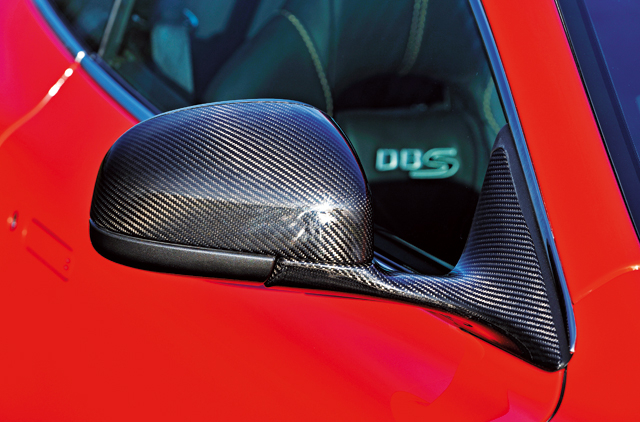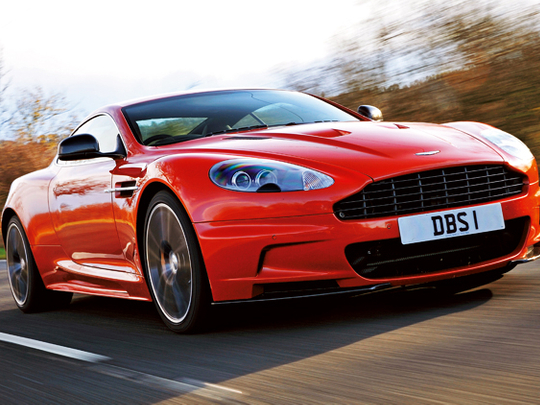
One hundred and sixty kilometres per hour passes on the speedometer and still the rear tyres are spinning. Fourth gear, a straight road (thankfully quiet) and the rear tyres are still struggling for traction. The electronic controls are off, there's a cloud of smoke and two black lines perfectly delineate the DBS's wayward tail and my heavy right foot.
Blame England's weather, as the road that's just been vandalised with rubber and smoke is just a few miles away from Aston Martin's Gaydon base. It's December. Alien as it might sound to UAE residents, Gaydon in December means little sun, very little light and as a result not much heat. Usually none in fact. Which is why Aston Martin has fitted this DBS with winter tyres. They're supposed to give greater grip in sub-seven-degree temperatures but, at a relatively balmy nine degrees, they're not working too well (with the traction control disabled). There's some heat in them now though. Imagine a typical UAE road after some rainfall or with a heavy covering of traction-and-grip-reducing sand and you'll have some kind of idea of what we're dealing with.
Which is fine in something ordinary, with sensible amounts of power, but the DBS is neither. No Aston Martin could ever be described as ordinary, and this side of a One-77 you'll not find a more powerful car wearing a winged Aston Martin badge. Behind that badge and under the long bonnet is a 6.0-litre V12 with 510bhp. Little wonder then that those tyres are struggling.
So it's not a particularly clever car for the UK's wintery roads, but Aston had a new Carbon Edition model begging to be driven and we weren't about to say no. That there's hardly any heat or light from the sun matters little either, as this car provides its own. Idle, at the side of the road, the bonnet vents provide a shimmering haze of heat from the engine below. It's unlikely that Paul Bolitho would have imagined the V12 he built for this car would be used to heat cold hands, but that's exactly what it's doing as we gather to chat around the bonnet.
The Flame Orange paintwork brightens up what's otherwise a pretty miserable day too, the grim climate forgotten with this DBS around. Truthfully, it's a car I've never really got on with. Too close to the DB9 in form — with some slightly awkward aftermarket-looking visual tweaks — its function is largely similar.
This car changes my opinion. From the first time I spot it parked at Aston Martin's visitor centre, I'm utterly drawn in. Astons should be subtle, a bit of British reserve rather than undignified brashness, but in Flame Orange it works, looking just right, the brightness and deep-lustre finish of the paintwork seemingly softening the rather busy lines that usually disrupt the flow and purity of the DB9's shape. More is more here, and the carbon-fibre trim additions that make up the Carbon Edition model give an even more alluring look to Aston's flagship machine.
It's not difficult to spot, as the fine, shiny black weave features on the door mirror caps, the rear diffuser, light surrounds and add-on winglets at the leading edge of the front bumper. Black grilles behind the heat-escaping vents and cool-air feeding intakes complement the carbon fibre, as do 20in gloss black wheels with a diamond turned finish. Behind those alloys are huge carbon ceramic brake discs, their fade-free matte speckled surface gripped by massive four-piston monoblock callipers finished in gold. Subtle it isn't.
In a range that now includes the Virage, the DBS has to work harder to justify its existence, and in Carbon Edition specification it does exactly that. The carbon trim pieces might do none of the lightness-adding you'd usually expect from the bonded material, but the hand layering ensures a perfect finish. The weave lines up perfectly, the attention to detail such that the rise and fall of contours are matched with the flow of the material. It's not often I'd suggest getting down on your hands and knees and inspecting a diffuser, but it's worth making an exception for the DBS. If you can't lower yourself to do so then make do with the wing mirrors.
If you're left in any doubt that this DBS is different from a regular production version then the carbon lettering on the sills when you open the door give an obvious clue. As does the quilted leather headlining and sports seats in Obsidian Black with Kestrel Tan contrasting stitching. Aston Martin's new sat-nav system, introduced with the Virage and developed with Garmin, also features, its functionality improving greatly over the clunky Volvo-sourced system of old. That's not to say the DBS's cabin is perfect, but it's refreshingly devoid of the sort of technical overload that blights virtually everything today. So there's no laser guided cruise control, no lane departure warnings and no driver drowsiness detection systems.
It's unlikely you'll need the latter, as, while the DBS does a fine job as a dignified and serene GT car, the combination of that 510bhp V12 and savage performance does corrupt. Unlike the DB9 it's unlikely you'll find yourself taking it easy, as the DBS is a rawer, more involving and exciting car to drive. It's why you'll find yourself in fourth gear at 160kph with the traction control off having left several hundred metres of black lines on a quiet road. The DBS goads you into driving it, the edginess of the winter tyres on poor UK roads actually making it more amusing, if ultimately detracting from its ultimate ability to carry huge speed.
The DBS's V12 engine might share its capacity with the DB9 and Virage, but it is freer breathing and revs higher with more urgency, peak power arriving at 6,500rpm and peak torque of 570Nm at 5,750rpm. Those numbers suggest an engine that needs revs to produce its best, but there's plenty of muscle at lower engine speeds.It's brutally quick, feeling more potent than its official 4.3-second 0-100kph time. More brutal through the entire range you've barely got enough time to flick the six-speed Touchtronic's right hand paddle-shifter for a new gear before the engine demands another. Inexplicably, the carbon-finished paddles promised at the Carbon Edition's announcement haven't made it through to production, so those gear changes feel no different at your fingertips, though they're as quick and smooth as you'd expect.
While the DBS's engine shocks with its raw, savage performance, the chassis delights with its suppleness. Obviously derived from the DB9, the DBS's suspension has been altered to suit its more hardcore role, riding on a wider track and with different anti-roll and spring settings. Adaptive damping is offered in either Sport or Comfort modes, but it automatically changes to suit conditions, allowing the DBS to ride with surprising composure. Lower unsprung mass from those carbon ceramic brakes helps, as does the DBS's marginally lighter overall weight over its DB9 and Virage relations. Even narrow, undulating UK roads are tackled with real poise, allowing the DBS to make use of its easily gained speed.
Quick, nicely weighted steering aids the DBS's ability to carry its pace, the nose faithfully turning in, though the wheel itself lacks in the sort of crisp feel that appeals when you're guiding such a potent machine. The rear, more wayward here than usual on its winter tyres, does fidget around, the back stepping out under power when you select the Track Mode stability setting, which allows a good angle of slip before reining in your over enthusiasm. It's all hugely entertaining, if lacking the precision of some of the DBS's more overtly sporting rivals.
That's thanks to its genealogy, as despite the significant revisions, underneath the DBS retains the GT feel of its DB9 relative, albeit with heightened intensity and pace. Whether that's a positive thing is down to personal preference, but the same engine in the Vantage body does feel a bit more supercar than super GT. The V12 Vantage is significantly cheaper, too. That's perhaps the biggest issue for the DBS; for all its ability it remains too much a derivative of its ‘lesser' relations, and that does make its lofty price tag difficult to stomach.
The Aston may be a different proposition to something like Ferrari's 458 Italia, yet the Italian does everything the DBS does — aside from offering a pair of rear ‘seats' — and performs at an even higher level for less money.
The Carbon Edition does add visual appeal to the DBS, but there's no denying that it sits relatively uncomfortably in Aston Martin's line-up, and oddly among its rivals.
It remains an anomaly, a bit of a hooligan that's unquestionably entertaining, but lacking a distinct role. Unless you're partial to 160kph burnouts.
Specs & ratings
- Model DBS Carbon Edition
- Engine 6.0-litre V12
- Transmission Six-speed Touchtronic auto, RWD
- Max power 510bhp @ 6,500rpm
- Max torque 570Nm @ 5,750rpm
- Top speed 307kph
- 0-100kph 4.3sec


